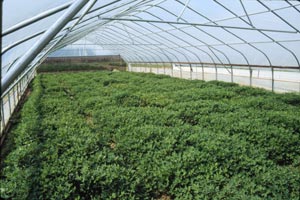|
|
|
 |
| Peanut Mission |

|
|
Development of Improved Peanut Germplasm with Resistance to Disease and Nematode Pests
| Development of peanut germplasm with resistance to Preharvest Aflatoxin Contamination:
Aflatoxin contamination in peanut is an extremely variable characteristic that primarily occurs under heat and drought stress. There are two requirements for developing cultivars with resistance to preharvest aflatoxin contamination (PAC). First there must be genetic variance for resistance. In other words, there must be a gene or genes for resistance. The second requirement for developing resistance is the availability of reliable and efficient screening techniques. These techniques are needed so that plants containing genes for resistance can be reliably and efficiently identified. |
 |
| Development of peanut germplasm with resistance to the root-knot nematode:
The root-knot nematode is a microscopic worm that feeds on the roots, pegs, and pods of peanut plants. This nematode can greatly reduce yield and quality and costs U.S. peanut farmers over 30 million dollars annually. All peanut cultivars are susceptible to this pest. To begin the process of developing resistant cultivars we are searching the germplasm collection (>7,000 types of peanuts) for sources of genes for resistance.
|
 |
| Development of improved methods for utilizing the national peanut germplasm collection:
The size of germplasm collections for all crops increases over time, which in turn increases the costs of collection maintenance and the evaluation expenses needed to identify particular genes. The testing and refinement of the core collection theory is expected to reduce these expenses for all crop species.
|
 |
|
|
|
|
|
|
|
Last Modified: 04/14/2009
|
|